Friendship and Betrayal in the Digital Age
VerifiedAdded on 2020/04/13
|8
|2573
|151
AI Summary
This assignment delves into the complex theme of friendship through a fictional narrative. A young man named Alan becomes a victim of a cybercrime orchestrated by his close friend George, who uses hacking to fabricate an email damaging Alan's reputation. The story highlights the vulnerability of online interactions and the devastating consequences when betrayal occurs within the context of close relationships.
Contribute Materials
Your contribution can guide someone’s learning journey. Share your
documents today.
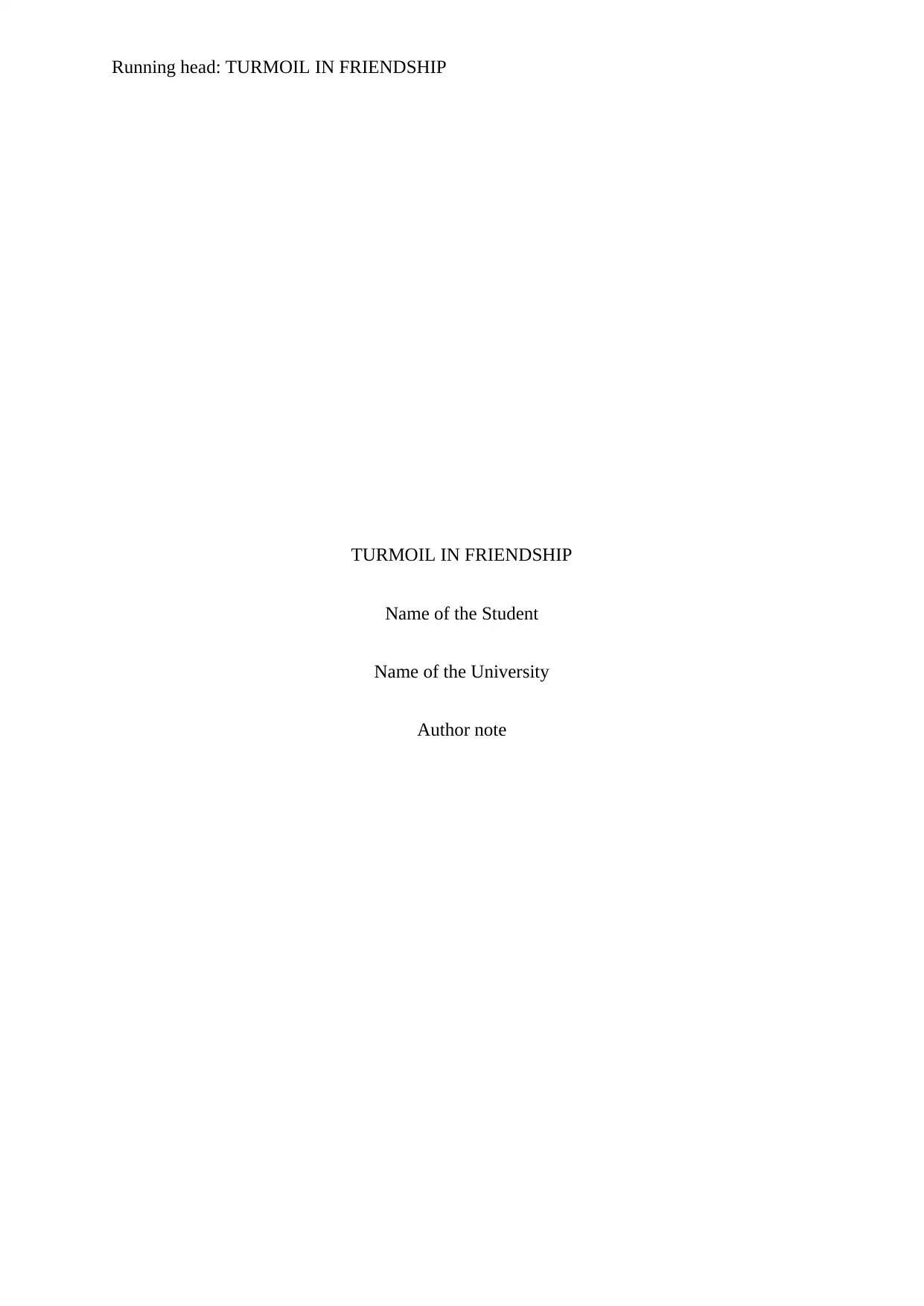
Running head: TURMOIL IN FRIENDSHIP
TURMOIL IN FRIENDSHIP
Name of the Student
Name of the University
Author note
TURMOIL IN FRIENDSHIP
Name of the Student
Name of the University
Author note
Secure Best Marks with AI Grader
Need help grading? Try our AI Grader for instant feedback on your assignments.
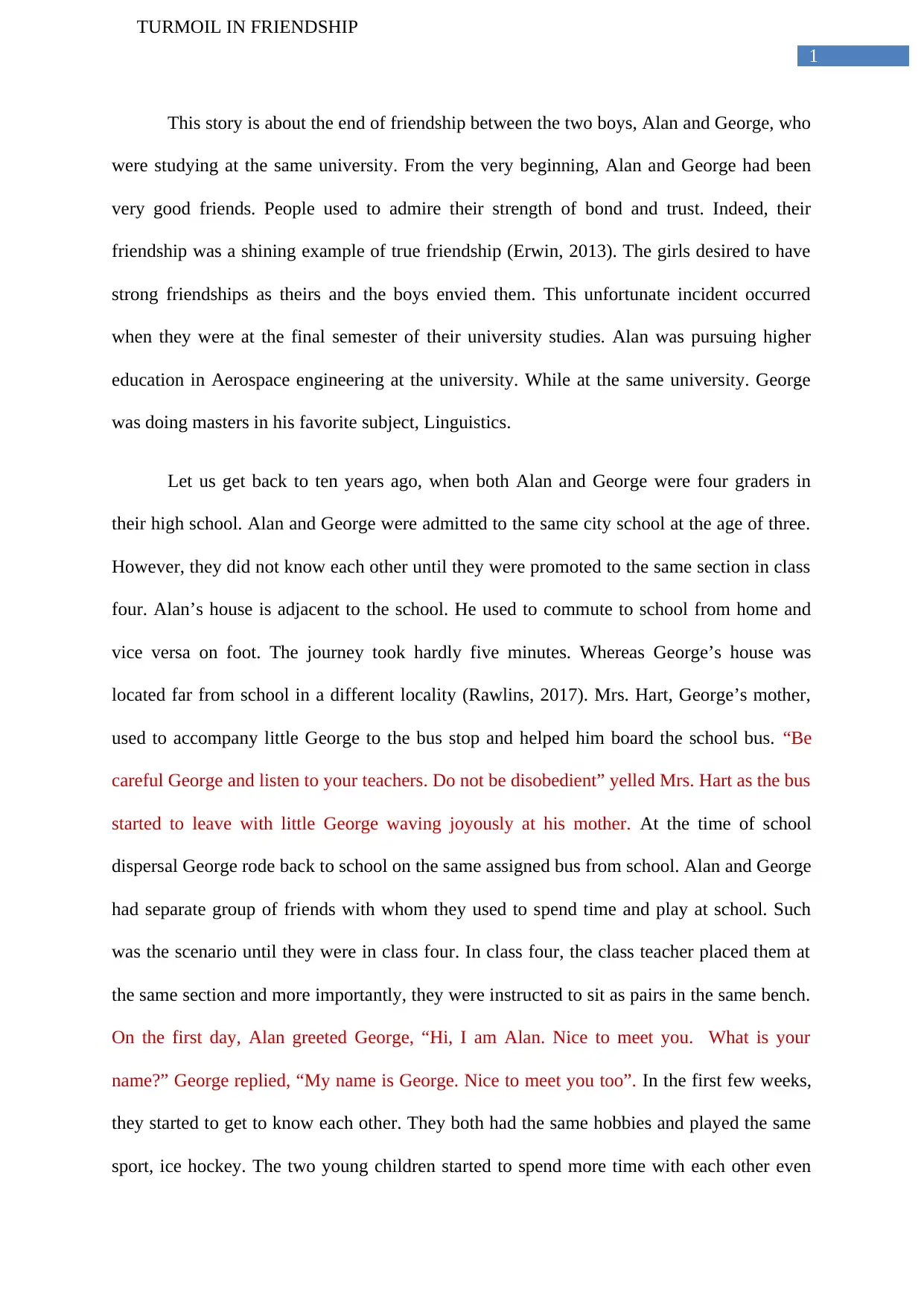
1
TURMOIL IN FRIENDSHIP
This story is about the end of friendship between the two boys, Alan and George, who
were studying at the same university. From the very beginning, Alan and George had been
very good friends. People used to admire their strength of bond and trust. Indeed, their
friendship was a shining example of true friendship (Erwin, 2013). The girls desired to have
strong friendships as theirs and the boys envied them. This unfortunate incident occurred
when they were at the final semester of their university studies. Alan was pursuing higher
education in Aerospace engineering at the university. While at the same university. George
was doing masters in his favorite subject, Linguistics.
Let us get back to ten years ago, when both Alan and George were four graders in
their high school. Alan and George were admitted to the same city school at the age of three.
However, they did not know each other until they were promoted to the same section in class
four. Alan’s house is adjacent to the school. He used to commute to school from home and
vice versa on foot. The journey took hardly five minutes. Whereas George’s house was
located far from school in a different locality (Rawlins, 2017). Mrs. Hart, George’s mother,
used to accompany little George to the bus stop and helped him board the school bus. “Be
careful George and listen to your teachers. Do not be disobedient” yelled Mrs. Hart as the bus
started to leave with little George waving joyously at his mother. At the time of school
dispersal George rode back to school on the same assigned bus from school. Alan and George
had separate group of friends with whom they used to spend time and play at school. Such
was the scenario until they were in class four. In class four, the class teacher placed them at
the same section and more importantly, they were instructed to sit as pairs in the same bench.
On the first day, Alan greeted George, “Hi, I am Alan. Nice to meet you. What is your
name?” George replied, “My name is George. Nice to meet you too”. In the first few weeks,
they started to get to know each other. They both had the same hobbies and played the same
sport, ice hockey. The two young children started to spend more time with each other even
TURMOIL IN FRIENDSHIP
This story is about the end of friendship between the two boys, Alan and George, who
were studying at the same university. From the very beginning, Alan and George had been
very good friends. People used to admire their strength of bond and trust. Indeed, their
friendship was a shining example of true friendship (Erwin, 2013). The girls desired to have
strong friendships as theirs and the boys envied them. This unfortunate incident occurred
when they were at the final semester of their university studies. Alan was pursuing higher
education in Aerospace engineering at the university. While at the same university. George
was doing masters in his favorite subject, Linguistics.
Let us get back to ten years ago, when both Alan and George were four graders in
their high school. Alan and George were admitted to the same city school at the age of three.
However, they did not know each other until they were promoted to the same section in class
four. Alan’s house is adjacent to the school. He used to commute to school from home and
vice versa on foot. The journey took hardly five minutes. Whereas George’s house was
located far from school in a different locality (Rawlins, 2017). Mrs. Hart, George’s mother,
used to accompany little George to the bus stop and helped him board the school bus. “Be
careful George and listen to your teachers. Do not be disobedient” yelled Mrs. Hart as the bus
started to leave with little George waving joyously at his mother. At the time of school
dispersal George rode back to school on the same assigned bus from school. Alan and George
had separate group of friends with whom they used to spend time and play at school. Such
was the scenario until they were in class four. In class four, the class teacher placed them at
the same section and more importantly, they were instructed to sit as pairs in the same bench.
On the first day, Alan greeted George, “Hi, I am Alan. Nice to meet you. What is your
name?” George replied, “My name is George. Nice to meet you too”. In the first few weeks,
they started to get to know each other. They both had the same hobbies and played the same
sport, ice hockey. The two young children started to spend more time with each other even
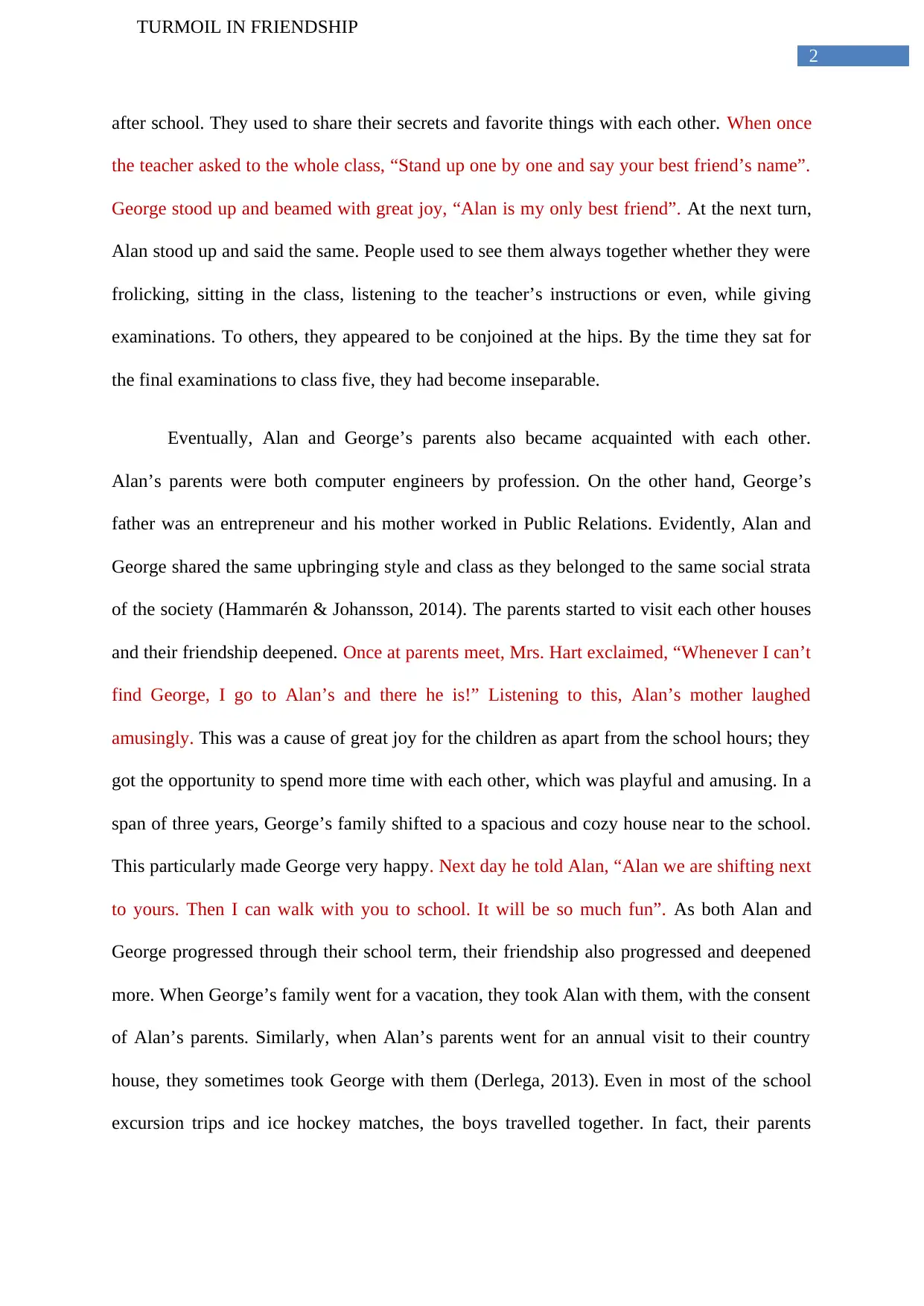
2
TURMOIL IN FRIENDSHIP
after school. They used to share their secrets and favorite things with each other. When once
the teacher asked to the whole class, “Stand up one by one and say your best friend’s name”.
George stood up and beamed with great joy, “Alan is my only best friend”. At the next turn,
Alan stood up and said the same. People used to see them always together whether they were
frolicking, sitting in the class, listening to the teacher’s instructions or even, while giving
examinations. To others, they appeared to be conjoined at the hips. By the time they sat for
the final examinations to class five, they had become inseparable.
Eventually, Alan and George’s parents also became acquainted with each other.
Alan’s parents were both computer engineers by profession. On the other hand, George’s
father was an entrepreneur and his mother worked in Public Relations. Evidently, Alan and
George shared the same upbringing style and class as they belonged to the same social strata
of the society (Hammarén & Johansson, 2014). The parents started to visit each other houses
and their friendship deepened. Once at parents meet, Mrs. Hart exclaimed, “Whenever I can’t
find George, I go to Alan’s and there he is!” Listening to this, Alan’s mother laughed
amusingly. This was a cause of great joy for the children as apart from the school hours; they
got the opportunity to spend more time with each other, which was playful and amusing. In a
span of three years, George’s family shifted to a spacious and cozy house near to the school.
This particularly made George very happy. Next day he told Alan, “Alan we are shifting next
to yours. Then I can walk with you to school. It will be so much fun”. As both Alan and
George progressed through their school term, their friendship also progressed and deepened
more. When George’s family went for a vacation, they took Alan with them, with the consent
of Alan’s parents. Similarly, when Alan’s parents went for an annual visit to their country
house, they sometimes took George with them (Derlega, 2013). Even in most of the school
excursion trips and ice hockey matches, the boys travelled together. In fact, their parents
TURMOIL IN FRIENDSHIP
after school. They used to share their secrets and favorite things with each other. When once
the teacher asked to the whole class, “Stand up one by one and say your best friend’s name”.
George stood up and beamed with great joy, “Alan is my only best friend”. At the next turn,
Alan stood up and said the same. People used to see them always together whether they were
frolicking, sitting in the class, listening to the teacher’s instructions or even, while giving
examinations. To others, they appeared to be conjoined at the hips. By the time they sat for
the final examinations to class five, they had become inseparable.
Eventually, Alan and George’s parents also became acquainted with each other.
Alan’s parents were both computer engineers by profession. On the other hand, George’s
father was an entrepreneur and his mother worked in Public Relations. Evidently, Alan and
George shared the same upbringing style and class as they belonged to the same social strata
of the society (Hammarén & Johansson, 2014). The parents started to visit each other houses
and their friendship deepened. Once at parents meet, Mrs. Hart exclaimed, “Whenever I can’t
find George, I go to Alan’s and there he is!” Listening to this, Alan’s mother laughed
amusingly. This was a cause of great joy for the children as apart from the school hours; they
got the opportunity to spend more time with each other, which was playful and amusing. In a
span of three years, George’s family shifted to a spacious and cozy house near to the school.
This particularly made George very happy. Next day he told Alan, “Alan we are shifting next
to yours. Then I can walk with you to school. It will be so much fun”. As both Alan and
George progressed through their school term, their friendship also progressed and deepened
more. When George’s family went for a vacation, they took Alan with them, with the consent
of Alan’s parents. Similarly, when Alan’s parents went for an annual visit to their country
house, they sometimes took George with them (Derlega, 2013). Even in most of the school
excursion trips and ice hockey matches, the boys travelled together. In fact, their parents
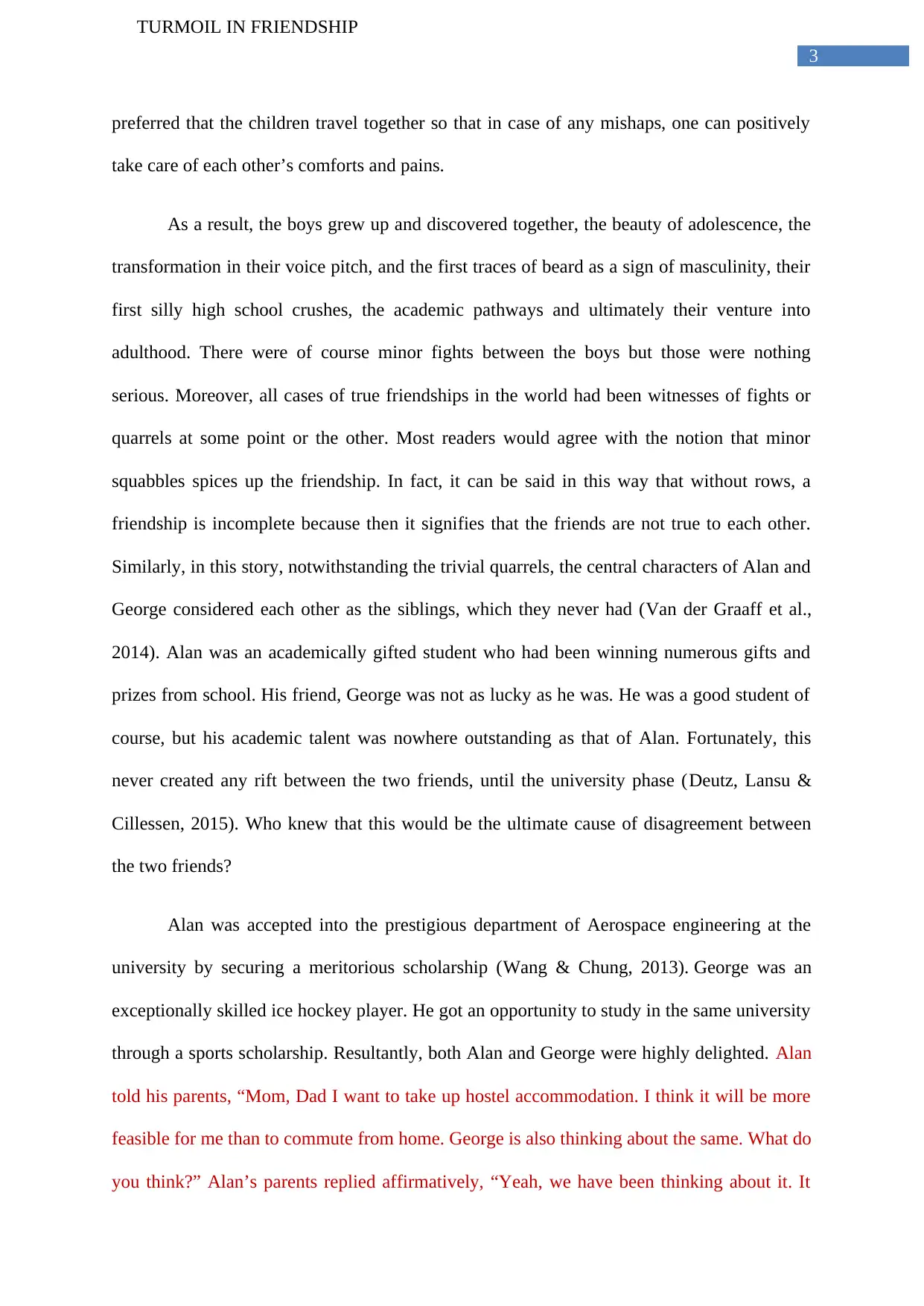
3
TURMOIL IN FRIENDSHIP
preferred that the children travel together so that in case of any mishaps, one can positively
take care of each other’s comforts and pains.
As a result, the boys grew up and discovered together, the beauty of adolescence, the
transformation in their voice pitch, and the first traces of beard as a sign of masculinity, their
first silly high school crushes, the academic pathways and ultimately their venture into
adulthood. There were of course minor fights between the boys but those were nothing
serious. Moreover, all cases of true friendships in the world had been witnesses of fights or
quarrels at some point or the other. Most readers would agree with the notion that minor
squabbles spices up the friendship. In fact, it can be said in this way that without rows, a
friendship is incomplete because then it signifies that the friends are not true to each other.
Similarly, in this story, notwithstanding the trivial quarrels, the central characters of Alan and
George considered each other as the siblings, which they never had (Van der Graaff et al.,
2014). Alan was an academically gifted student who had been winning numerous gifts and
prizes from school. His friend, George was not as lucky as he was. He was a good student of
course, but his academic talent was nowhere outstanding as that of Alan. Fortunately, this
never created any rift between the two friends, until the university phase (Deutz, Lansu &
Cillessen, 2015). Who knew that this would be the ultimate cause of disagreement between
the two friends?
Alan was accepted into the prestigious department of Aerospace engineering at the
university by securing a meritorious scholarship (Wang & Chung, 2013). George was an
exceptionally skilled ice hockey player. He got an opportunity to study in the same university
through a sports scholarship. Resultantly, both Alan and George were highly delighted. Alan
told his parents, “Mom, Dad I want to take up hostel accommodation. I think it will be more
feasible for me than to commute from home. George is also thinking about the same. What do
you think?” Alan’s parents replied affirmatively, “Yeah, we have been thinking about it. It
TURMOIL IN FRIENDSHIP
preferred that the children travel together so that in case of any mishaps, one can positively
take care of each other’s comforts and pains.
As a result, the boys grew up and discovered together, the beauty of adolescence, the
transformation in their voice pitch, and the first traces of beard as a sign of masculinity, their
first silly high school crushes, the academic pathways and ultimately their venture into
adulthood. There were of course minor fights between the boys but those were nothing
serious. Moreover, all cases of true friendships in the world had been witnesses of fights or
quarrels at some point or the other. Most readers would agree with the notion that minor
squabbles spices up the friendship. In fact, it can be said in this way that without rows, a
friendship is incomplete because then it signifies that the friends are not true to each other.
Similarly, in this story, notwithstanding the trivial quarrels, the central characters of Alan and
George considered each other as the siblings, which they never had (Van der Graaff et al.,
2014). Alan was an academically gifted student who had been winning numerous gifts and
prizes from school. His friend, George was not as lucky as he was. He was a good student of
course, but his academic talent was nowhere outstanding as that of Alan. Fortunately, this
never created any rift between the two friends, until the university phase (Deutz, Lansu &
Cillessen, 2015). Who knew that this would be the ultimate cause of disagreement between
the two friends?
Alan was accepted into the prestigious department of Aerospace engineering at the
university by securing a meritorious scholarship (Wang & Chung, 2013). George was an
exceptionally skilled ice hockey player. He got an opportunity to study in the same university
through a sports scholarship. Resultantly, both Alan and George were highly delighted. Alan
told his parents, “Mom, Dad I want to take up hostel accommodation. I think it will be more
feasible for me than to commute from home. George is also thinking about the same. What do
you think?” Alan’s parents replied affirmatively, “Yeah, we have been thinking about it. It
Secure Best Marks with AI Grader
Need help grading? Try our AI Grader for instant feedback on your assignments.
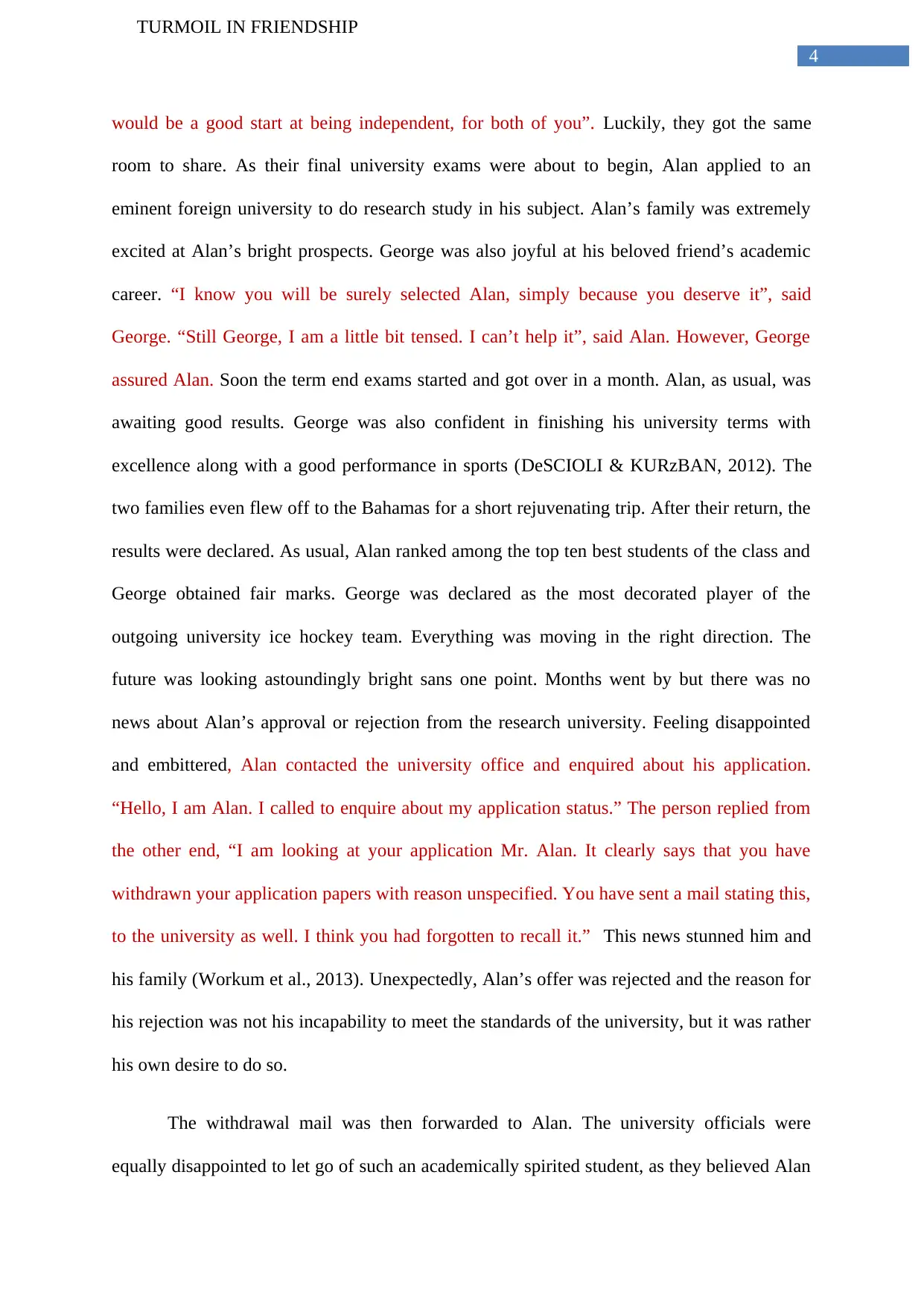
4
TURMOIL IN FRIENDSHIP
would be a good start at being independent, for both of you”. Luckily, they got the same
room to share. As their final university exams were about to begin, Alan applied to an
eminent foreign university to do research study in his subject. Alan’s family was extremely
excited at Alan’s bright prospects. George was also joyful at his beloved friend’s academic
career. “I know you will be surely selected Alan, simply because you deserve it”, said
George. “Still George, I am a little bit tensed. I can’t help it”, said Alan. However, George
assured Alan. Soon the term end exams started and got over in a month. Alan, as usual, was
awaiting good results. George was also confident in finishing his university terms with
excellence along with a good performance in sports (DeSCIOLI & KURzBAN, 2012). The
two families even flew off to the Bahamas for a short rejuvenating trip. After their return, the
results were declared. As usual, Alan ranked among the top ten best students of the class and
George obtained fair marks. George was declared as the most decorated player of the
outgoing university ice hockey team. Everything was moving in the right direction. The
future was looking astoundingly bright sans one point. Months went by but there was no
news about Alan’s approval or rejection from the research university. Feeling disappointed
and embittered, Alan contacted the university office and enquired about his application.
“Hello, I am Alan. I called to enquire about my application status.” The person replied from
the other end, “I am looking at your application Mr. Alan. It clearly says that you have
withdrawn your application papers with reason unspecified. You have sent a mail stating this,
to the university as well. I think you had forgotten to recall it.” This news stunned him and
his family (Workum et al., 2013). Unexpectedly, Alan’s offer was rejected and the reason for
his rejection was not his incapability to meet the standards of the university, but it was rather
his own desire to do so.
The withdrawal mail was then forwarded to Alan. The university officials were
equally disappointed to let go of such an academically spirited student, as they believed Alan
TURMOIL IN FRIENDSHIP
would be a good start at being independent, for both of you”. Luckily, they got the same
room to share. As their final university exams were about to begin, Alan applied to an
eminent foreign university to do research study in his subject. Alan’s family was extremely
excited at Alan’s bright prospects. George was also joyful at his beloved friend’s academic
career. “I know you will be surely selected Alan, simply because you deserve it”, said
George. “Still George, I am a little bit tensed. I can’t help it”, said Alan. However, George
assured Alan. Soon the term end exams started and got over in a month. Alan, as usual, was
awaiting good results. George was also confident in finishing his university terms with
excellence along with a good performance in sports (DeSCIOLI & KURzBAN, 2012). The
two families even flew off to the Bahamas for a short rejuvenating trip. After their return, the
results were declared. As usual, Alan ranked among the top ten best students of the class and
George obtained fair marks. George was declared as the most decorated player of the
outgoing university ice hockey team. Everything was moving in the right direction. The
future was looking astoundingly bright sans one point. Months went by but there was no
news about Alan’s approval or rejection from the research university. Feeling disappointed
and embittered, Alan contacted the university office and enquired about his application.
“Hello, I am Alan. I called to enquire about my application status.” The person replied from
the other end, “I am looking at your application Mr. Alan. It clearly says that you have
withdrawn your application papers with reason unspecified. You have sent a mail stating this,
to the university as well. I think you had forgotten to recall it.” This news stunned him and
his family (Workum et al., 2013). Unexpectedly, Alan’s offer was rejected and the reason for
his rejection was not his incapability to meet the standards of the university, but it was rather
his own desire to do so.
The withdrawal mail was then forwarded to Alan. The university officials were
equally disappointed to let go of such an academically spirited student, as they believed Alan
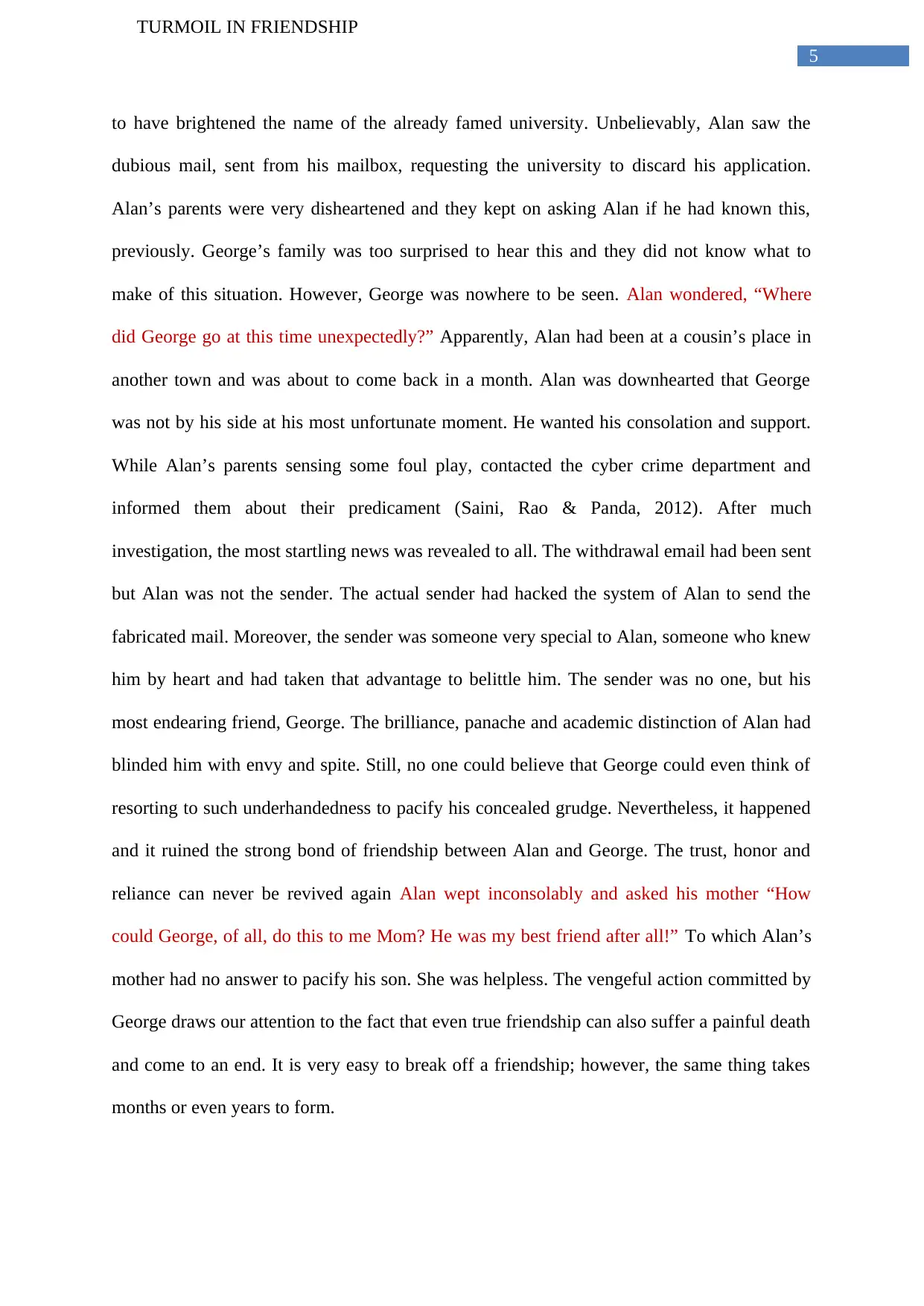
5
TURMOIL IN FRIENDSHIP
to have brightened the name of the already famed university. Unbelievably, Alan saw the
dubious mail, sent from his mailbox, requesting the university to discard his application.
Alan’s parents were very disheartened and they kept on asking Alan if he had known this,
previously. George’s family was too surprised to hear this and they did not know what to
make of this situation. However, George was nowhere to be seen. Alan wondered, “Where
did George go at this time unexpectedly?” Apparently, Alan had been at a cousin’s place in
another town and was about to come back in a month. Alan was downhearted that George
was not by his side at his most unfortunate moment. He wanted his consolation and support.
While Alan’s parents sensing some foul play, contacted the cyber crime department and
informed them about their predicament (Saini, Rao & Panda, 2012). After much
investigation, the most startling news was revealed to all. The withdrawal email had been sent
but Alan was not the sender. The actual sender had hacked the system of Alan to send the
fabricated mail. Moreover, the sender was someone very special to Alan, someone who knew
him by heart and had taken that advantage to belittle him. The sender was no one, but his
most endearing friend, George. The brilliance, panache and academic distinction of Alan had
blinded him with envy and spite. Still, no one could believe that George could even think of
resorting to such underhandedness to pacify his concealed grudge. Nevertheless, it happened
and it ruined the strong bond of friendship between Alan and George. The trust, honor and
reliance can never be revived again Alan wept inconsolably and asked his mother “How
could George, of all, do this to me Mom? He was my best friend after all!” To which Alan’s
mother had no answer to pacify his son. She was helpless. The vengeful action committed by
George draws our attention to the fact that even true friendship can also suffer a painful death
and come to an end. It is very easy to break off a friendship; however, the same thing takes
months or even years to form.
TURMOIL IN FRIENDSHIP
to have brightened the name of the already famed university. Unbelievably, Alan saw the
dubious mail, sent from his mailbox, requesting the university to discard his application.
Alan’s parents were very disheartened and they kept on asking Alan if he had known this,
previously. George’s family was too surprised to hear this and they did not know what to
make of this situation. However, George was nowhere to be seen. Alan wondered, “Where
did George go at this time unexpectedly?” Apparently, Alan had been at a cousin’s place in
another town and was about to come back in a month. Alan was downhearted that George
was not by his side at his most unfortunate moment. He wanted his consolation and support.
While Alan’s parents sensing some foul play, contacted the cyber crime department and
informed them about their predicament (Saini, Rao & Panda, 2012). After much
investigation, the most startling news was revealed to all. The withdrawal email had been sent
but Alan was not the sender. The actual sender had hacked the system of Alan to send the
fabricated mail. Moreover, the sender was someone very special to Alan, someone who knew
him by heart and had taken that advantage to belittle him. The sender was no one, but his
most endearing friend, George. The brilliance, panache and academic distinction of Alan had
blinded him with envy and spite. Still, no one could believe that George could even think of
resorting to such underhandedness to pacify his concealed grudge. Nevertheless, it happened
and it ruined the strong bond of friendship between Alan and George. The trust, honor and
reliance can never be revived again Alan wept inconsolably and asked his mother “How
could George, of all, do this to me Mom? He was my best friend after all!” To which Alan’s
mother had no answer to pacify his son. She was helpless. The vengeful action committed by
George draws our attention to the fact that even true friendship can also suffer a painful death
and come to an end. It is very easy to break off a friendship; however, the same thing takes
months or even years to form.
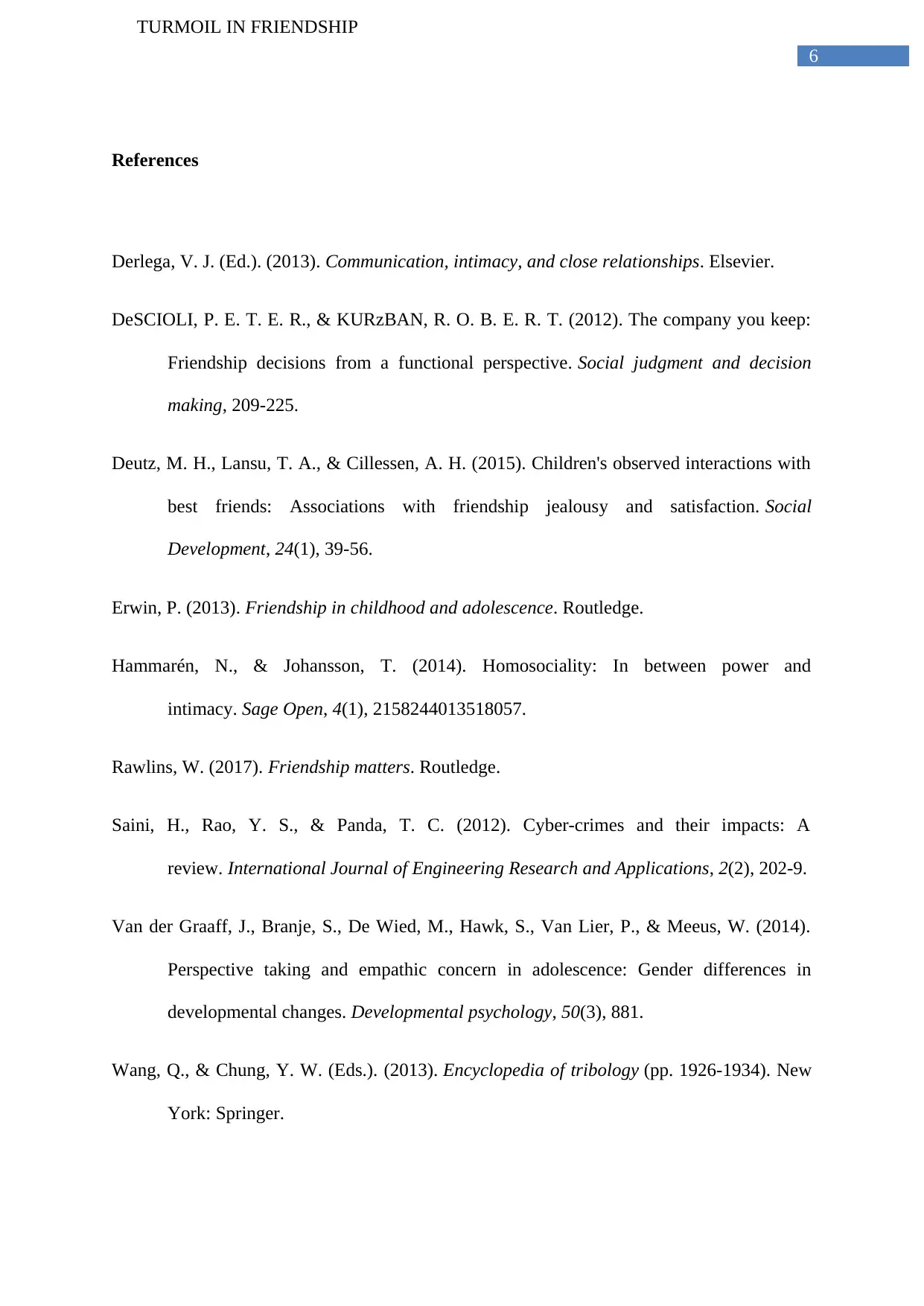
6
TURMOIL IN FRIENDSHIP
References
Derlega, V. J. (Ed.). (2013). Communication, intimacy, and close relationships. Elsevier.
DeSCIOLI, P. E. T. E. R., & KURzBAN, R. O. B. E. R. T. (2012). The company you keep:
Friendship decisions from a functional perspective. Social judgment and decision
making, 209-225.
Deutz, M. H., Lansu, T. A., & Cillessen, A. H. (2015). Children's observed interactions with
best friends: Associations with friendship jealousy and satisfaction. Social
Development, 24(1), 39-56.
Erwin, P. (2013). Friendship in childhood and adolescence. Routledge.
Hammarén, N., & Johansson, T. (2014). Homosociality: In between power and
intimacy. Sage Open, 4(1), 2158244013518057.
Rawlins, W. (2017). Friendship matters. Routledge.
Saini, H., Rao, Y. S., & Panda, T. C. (2012). Cyber-crimes and their impacts: A
review. International Journal of Engineering Research and Applications, 2(2), 202-9.
Van der Graaff, J., Branje, S., De Wied, M., Hawk, S., Van Lier, P., & Meeus, W. (2014).
Perspective taking and empathic concern in adolescence: Gender differences in
developmental changes. Developmental psychology, 50(3), 881.
Wang, Q., & Chung, Y. W. (Eds.). (2013). Encyclopedia of tribology (pp. 1926-1934). New
York: Springer.
TURMOIL IN FRIENDSHIP
References
Derlega, V. J. (Ed.). (2013). Communication, intimacy, and close relationships. Elsevier.
DeSCIOLI, P. E. T. E. R., & KURzBAN, R. O. B. E. R. T. (2012). The company you keep:
Friendship decisions from a functional perspective. Social judgment and decision
making, 209-225.
Deutz, M. H., Lansu, T. A., & Cillessen, A. H. (2015). Children's observed interactions with
best friends: Associations with friendship jealousy and satisfaction. Social
Development, 24(1), 39-56.
Erwin, P. (2013). Friendship in childhood and adolescence. Routledge.
Hammarén, N., & Johansson, T. (2014). Homosociality: In between power and
intimacy. Sage Open, 4(1), 2158244013518057.
Rawlins, W. (2017). Friendship matters. Routledge.
Saini, H., Rao, Y. S., & Panda, T. C. (2012). Cyber-crimes and their impacts: A
review. International Journal of Engineering Research and Applications, 2(2), 202-9.
Van der Graaff, J., Branje, S., De Wied, M., Hawk, S., Van Lier, P., & Meeus, W. (2014).
Perspective taking and empathic concern in adolescence: Gender differences in
developmental changes. Developmental psychology, 50(3), 881.
Wang, Q., & Chung, Y. W. (Eds.). (2013). Encyclopedia of tribology (pp. 1926-1934). New
York: Springer.
Paraphrase This Document
Need a fresh take? Get an instant paraphrase of this document with our AI Paraphraser
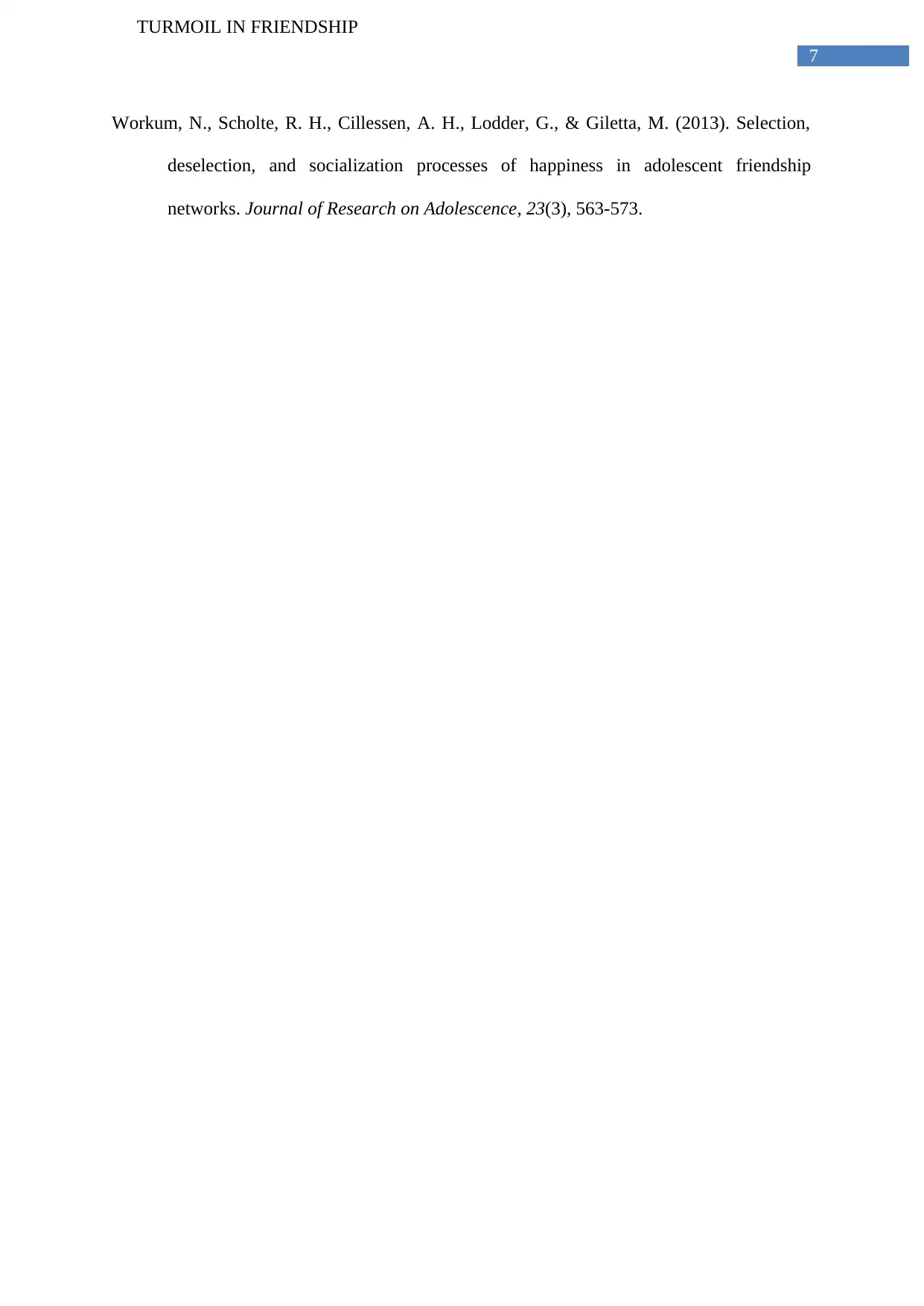
7
TURMOIL IN FRIENDSHIP
Workum, N., Scholte, R. H., Cillessen, A. H., Lodder, G., & Giletta, M. (2013). Selection,
deselection, and socialization processes of happiness in adolescent friendship
networks. Journal of Research on Adolescence, 23(3), 563-573.
TURMOIL IN FRIENDSHIP
Workum, N., Scholte, R. H., Cillessen, A. H., Lodder, G., & Giletta, M. (2013). Selection,
deselection, and socialization processes of happiness in adolescent friendship
networks. Journal of Research on Adolescence, 23(3), 563-573.
1 out of 8
Related Documents
Your All-in-One AI-Powered Toolkit for Academic Success.
+13062052269
info@desklib.com
Available 24*7 on WhatsApp / Email
![[object Object]](/_next/static/media/star-bottom.7253800d.svg)
Unlock your academic potential
© 2024 | Zucol Services PVT LTD | All rights reserved.
